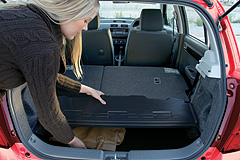New models - Suzuki - SwiftSport safer as Suzuki's slicker Swift surfacesLook closely: Revised Swift Sport gets a new grille, bumpers and alloys. Sport gets stability control as Suzuki upgrades its popular Swift pocket rocket30 Jun 2007 SUZUKI Australia has added standard electronic stability control to its Swift Sport mega-micro as part of a range-wide facelift for its biggest-selling model range. Launched in Japan just a month ago and on sale from today (July 1) at no extra cost, the upgraded Swift and Swift S feature new grilles and front and rear bumpers, different tail-lights and a new alloy wheel design. There are also two new paint colours - Ocean Blue and Nocturne Blue – but no sign of the side mirror-mounted indicators seen on Japanese examples. Inside resides a redesigned folding rear seat with portable luggage board to create a flat cargo area, plus new fabric seat upholstery. There are no mechanical changes to the model that comprises two-thirds of Suzuki’s sales in Australia.  That means the same 74kW/133Nm M15A 1.5-litre 16-valve VVT four-cylinder for the Swift and Swift S, mated to five-speed manual and four-speed automatic transmissions, and the same 92kW 1.6 for the manual-only Swift Sport, launched as the 1998-1999 Swift GTi hot-hatch’s spiritual successor in October 2006. That means the same 74kW/133Nm M15A 1.5-litre 16-valve VVT four-cylinder for the Swift and Swift S, mated to five-speed manual and four-speed automatic transmissions, and the same 92kW 1.6 for the manual-only Swift Sport, launched as the 1998-1999 Swift GTi hot-hatch’s spiritual successor in October 2006.The rejuvenated small-car brand doubled its sales in the 12 months following the new EZ-series Swift’s launch here in February 2005, leading to supply problems last year. So far this year the Swift has edged out more fancied nameplates such as Holden’s Barina to remain the third best-selling light car behind Toyota’s top-selling Yaris and the Hyundai Getz, which became Australia’s least expensive vehicle to offer stability control (as an option) in February last year. Prior to that, Smart’s two-seater ForTwo was the only other sub-$20,000 car to feature the potentially life-saving skid-control technology. The 1090kg Sport features a version of the Bosch-developed Electronic Stability Program (ESP) system that’s found in both Ford’s Territory – the first Australian vehicle to offer stability control – and Holden’s VE Commodore, Australia’s first car to come with it as standard. It combines the car’s standard ABS sensors with steering angle and lateral acceleration sensors, and joins the Swift’s armoury of twin front, front side and side curtain airbags. Since the Swift’s release here two and half years ago, Suzuki has also launched a new Grand Vitara SUV and the SX4 small hatch, which will form the basis for Suzuki’s fresh World Rally Championship assault in 2008. A modified Swift Super 1600 racer has dominated the first three rounds of the 2007 Junior WRC, including a clean-sweep of every stage in the rally of Portugal, and will feature in a new television commercial to promote the Swift upgrade, to be screened nationally from July 1. Prices remain unchanged at $16,000 for the entry-level Swift, $18,000 for the Swift S (add $2000 for an auto in both variants) and $24,000 for the Swift Sport. “Suzuki is committed to providing the highest levels of safety to its customers,” said Suzuki Australia’s automotive general manager, Tony Devers. “We have stayed true to the Suzuki philosophy of fantastic value for money by including ESP on the Swift Sport without adding to the price.”
Read more:First look: Swift facelift from SuzukiSwift pricing
Motor industry news |
|
||||||||||||














Facebook Twitter Instagram